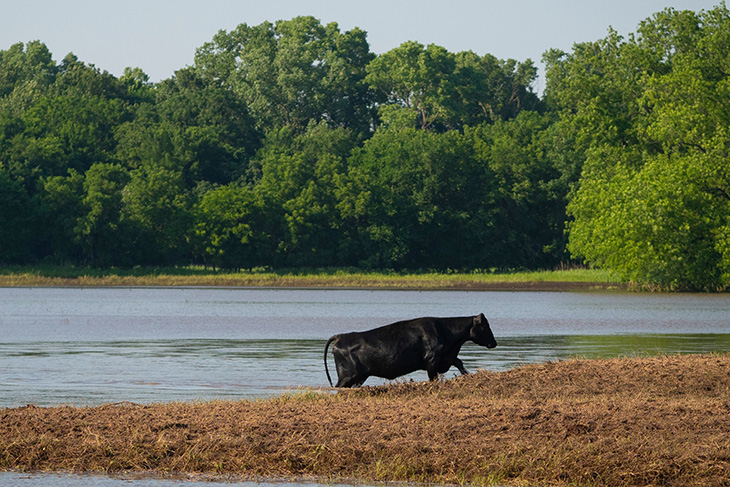
Cattle producers should watch for signs of blackleg and anthrax after floodwaters recede
Thursday, June 13, 2019
Livestock producers who recently experienced flooding events need to be on the lookout for signs of blackleg and anthrax in their cattle.
“Incidences of both diseases can easily occur in periods of dry weather after floodwaters recede,” said Dr. Barry Whitworth, Oklahoma State University Cooperative Extension veterinarian and food animal quality and health specialist. “Floodwaters disturb the soil, which can expose the spores that trigger the diseases. The floodwaters then can carry the spores into areas where cattle graze.”
Whitworth added cattle producers who experience the sudden death of their livestock after floodwaters recede should contact their veterinarian to attain a diagnosis. If anthrax is suspected, the Oklahoma Department of Agriculture, Food and Forestry state veterinarian also needs to be notified.
Blackleg is caused by Clostridium chauvoei. Anthrax is an infection caused by Bacillus anthracis. Both bacteria are found worldwide, and the diseases they cause tend to be acute and highly fatal.
“The bacteria primarily gain access to an animal’s body through ingestion, especially if the grass becomes short due to overgrazing or dry conditions,” Whitworth said. “To a lesser extent, both organisms may contaminate an open wound, and anthrax organisms may be inhaled.”
Blackleg typically is associated with cattle, but the disease can occur in other ruminants as well. Anthrax occurs mostly in ruminants but can occur in other animals, including humans.
In cases of blackleg, the onset of the disease typically occurs in livestock between 6 months and 2 years of age. Animals more than 2 years of age rarely contract the disease.
Whitworth said clinical signs of blackleg are rarely seen by livestock operators, with most producers simply finding dead animals.
“The few animals found alive often show signs of depression, lameness, swelling of an infected area, fever, pain and crepitus under the skin, which will feel and sound much like bubble wrap when palpitated,” he said.
In cases of anthrax, the disease is characterized by high fever, anorexia, abdominal pain, bloody urine or bloody diarrhea. This is typically followed by severe depression, respiratory distress, muscle tremors and convulsions in affected animals. Cattle of any age can contract anthrax.
“Animal carcasses tend to decompose rapidly,” Whitworth said. “Blood may exude from the mouth, nose and anus. With blackleg, the large muscles of the shoulder and hind leg will be swollen. This is typically where the crepitus can be felt. Lymph nodes may be swollen with anthrax.”
Whitworth cautions livestock producers against opening carcasses suspected of having blackleg or anthrax. First, it may allow spore formation to contaminate the soil in the area. Second, humans can contract anthrax so it is not worth the risk.
Treatment of blackleg is typically unrewarding; however, if an animal suffering from the disease is found to be alive, it can be administered large doses of antibiotics and supportive care. Anthrax, on the other hand, is very susceptible to many antibiotics if caught early enough.
“Producers should consult with their veterinarian in regards to proper antibiotic selection,” Whitworth said. “Again, it is vitally important livestock carcasses be dealt with properly to reduce the chance of soil contamination and spore formation. Deep burial of the carcass typically is necessary.”
Whitworth reminds cattle producers the best prevention strategy against blackleg is to vaccinate.
“Calves should be vaccinated between 60 and 90 days of age, followed by a second vaccination in four to six weeks,” he said. “Producers may only vaccinate for anthrax if approved by the state veterinarian.”
Livestock producers seeking additional information about blackleg, anthrax or proper carcass disposal methods should contact their local veterinarian or visit with the agricultural educator of their OSU Cooperative Extension county office, typically listed in local directories under “County Government.”
The Oklahoma Cooperative Extension Service is one of two state agencies administered by the OSU Division of Agricultural Sciences and Natural Resources, and is a key part of the university’s state and federally mandated teaching, research and Extension land-grant mission.
MEDIA CONTACT: Donald Stotts | Agricultural Communications Services | 405-744-4079 | donald.stotts@okstate.edu
